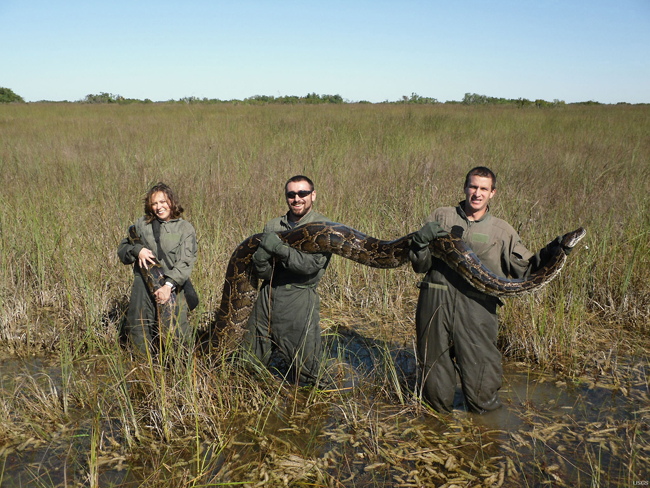Burmese Pythons Become Permanent Residents Within The Everglades
By Domenica Ghanem
Tens of thousands of Burmese pythons plague Everglades National Park and are believed to be the cause behind many of its vanishing mammals. After years of trying to capture and kill the pythons, the park now wants to contain and manage them.

Photo by National Park Service
“We’ll never eradicate them,” said Barbara Hedges, interpretive volunteer ranger at Everglades National Park. “It’s too late.”
In 12 years, the park has captured or found dead only 1,950 pythons. The greatest number in one year was 350 captures in 2009. There were more already dead or sluggish snakes during that year because the park experienced three nights of below freezing temperatures that winter.
But the park is not content to leave the snakes running rampant. Not while rabbits and foxes have completely vanished from the park and there has been an 87.5 percent decrease in bobcats since 2000, according to Hedges.
“It’s not that we’ve given up,” Linda Friar, spokeswoman for Everglades National Park said. “We’ve changed strategies.”
Park researchers track the snakes by capturing a female, inserting a chip into her and having her lead them to a group of male snakes. They call this a “Judas snake” according to Patrick Boyce, Big Cypress National Preserve park ranger.
The biggest challenge python hunters face is detection. Friar said the snakes are very cryptic. They are not attracted to traditional trappings and they use opportunistic hunting techniques.
Researchers have tried new detection approaches such as trying to attract them with pheromones, or mating scents. So far this technique has not been fully developed or successful.

Photo by Zarrin Ahmed.
Friar said they could be tracking a snake that has a chip in it, detect it within a foot and a half of them, and still may not see it.
“They’re 12-foot snakes so it’s kind of scary,” Friar said.
Hedges told a story about retired snake expert and wildlife biologist Skip Snow to illustrate just how difficult it is to see the pythons, even with tracking devices.
“He had a radio antenna and he says ‘I know it’s here, I know it’s here,’” Hedges said. “And then he stepped on it.”
Before his retirement, Snow was the on-site biologist most involved with Burmese pythons. Snow still occasionally helps with efforts to capture pythons in the park.
Friar said she believes that the Park Service could do more research on detection if it had more funding, such as investigating partnerships with local law enforcement canine units.
When the pythons are found, they are brought live in a pillowcase to the park’s science center where they are euthanized and used for research.
If the pythons are here to stay, why waste time, energy and resources on killing as many as possible?
No pythons have ever been known to kill humans in Florida in the wild; there have only been recorded incidences where pythons kill their pet owners. The odds of being killed by a snake are about 1 in 50 million, according to Hedges.
Boyce said there is a fine line between what is good for the wildlife and what is good for the people and there needs to be a balance.
“I don’t know if there are any sentimental people out there saying we should not kill them,” Boyce said. “They do not fit into the environment.”
According to Friar, the python has become detrimental to resources: consuming prey that native animals would consume and causing reductions in small mammals. This is why they are an invasive-exotic species, as opposed to simply an exotic species, like the Nile crocodile that was found in the late winter of this year, which hasn’t adapted or reproduced.
The Burmese python has not only bred and spread, but has also adapted. They have even been found in salt-water environments.
They are also classified as invasive-exotic because there is nothing keeping their population under control, Hedges said.
She explained how in Asia the Burmese python is categorized as “nearly threatened” because it has human predators that use its skin for leather and its body for food. Hedges said the alligator is supposed to be the top predator in the Everglades, but it is now competing with the python.
Not all snakes are removed from the park. There are 21 species of snakes found in Everglades National Park, four of which are venomous.
“Other snakes are good in the sense that they have an important role to play in the ecosystem,” Hedges said.
Florida law prohibits the release of pets into the wild. Everglades National Park hosts amnesty days, where people can bring their unwanted pets and zoos or other people will take them. This, along with educating children on responsible pet ownership, is one way the park is trying to manage the python population.
“They’re gentle and beautiful and you can buy them for about $20 at a snake show when they’re just little hatchlings,” Hedges said.
Legislation was passed in 2011 that banned the importation of Burmese pythons and a few other snakes. Before this law, people could purchase a licensing fee for $100 a year.
Friar said a concern bigger than the python is what the next invasive species will be. She said there have been reports of the African rock python, a nonvenomous snake typically found in Africa, on the land adjacent to Everglades National Park. It is similar to the Burmese python in that it is one of the five largest snake species and can eat animals the size of antelopes.
An interagency team is working on eradicating them before they make their way into the park and become another name on Florida’s long list of invasive-exotics.